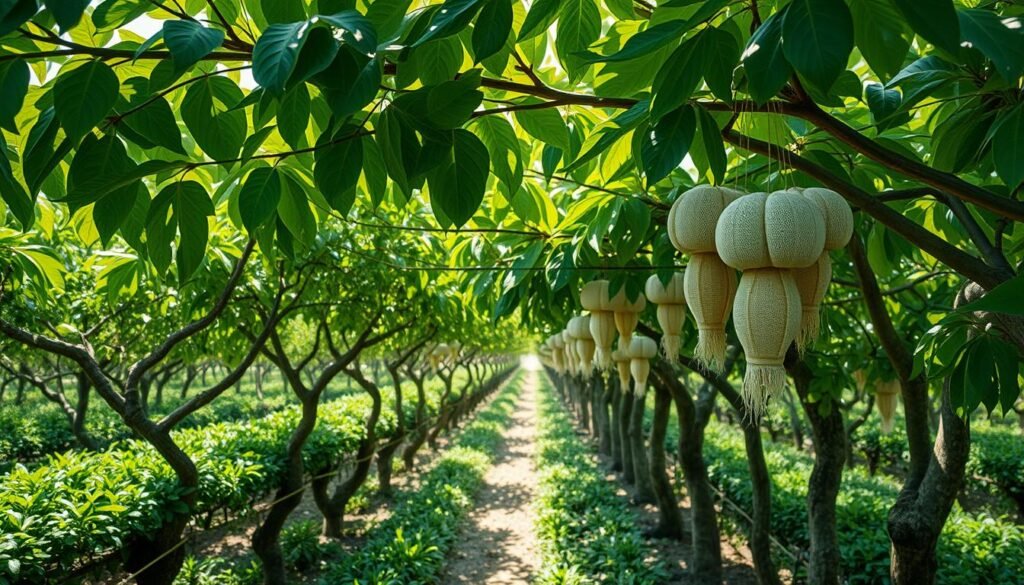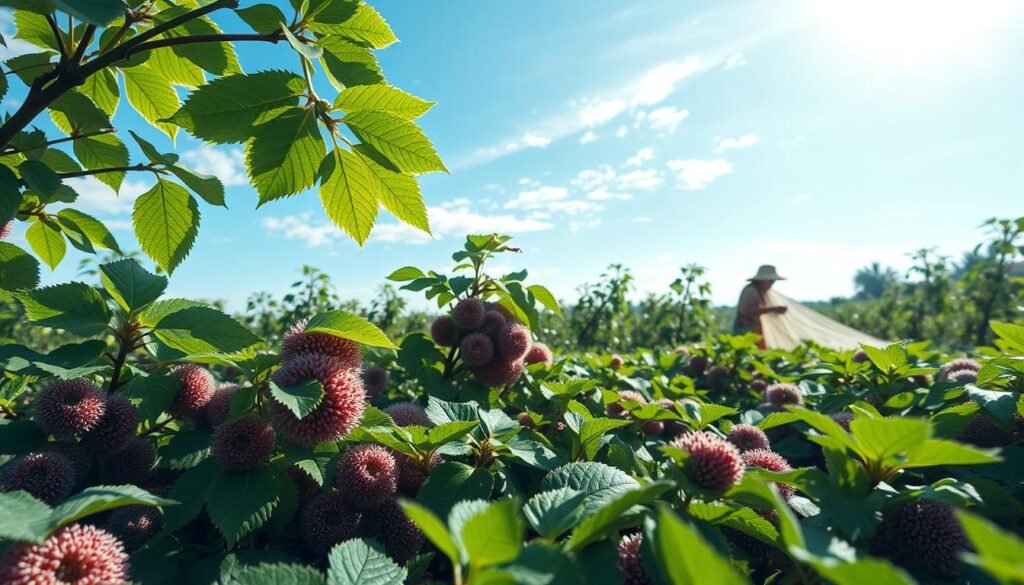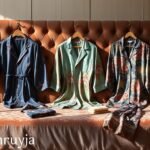Ever wondered how silk fabric, seen in fancy gowns and luxury home decor, is made? The making of this beautiful fabric starts with a simple silkworm and ends with amazing craftsmanship. We’ll explore the detailed process of making silk, showing how this loved fabric is created.
- It takes around 2,500 silkworms to produce one pound of raw silk1.
- Each silkworm produces just one strand of silk, which measures about 100 meters long and is held together by sericin1.
- Traditional silk dyeing uses dyes from things like fruit or indigo leaves. Now, synthetic dyes are also used1.
- Weaving is when two sets of threads are crossed to make strong, even silk fabric1.
- Silk finishing adds chemical treatments for things like fire resistance and keeping the silk smooth1.
What makes silk so special? How does it change from a silkworm’s cocoon to the luxurious fabric we adore? Let’s discover the secrets of making silk and see how this amazing textile comes to life.
What is Silk?
Silk comes from silkworms, the larvae of the Bombyx mori moth2. It’s known for being soft, strong, and shiny. This makes it a top choice for many people around the world.
The main part of silk is a protein called fibroin. Silkworms make this protein to build their cocoons2. Silk is great because it doesn’t cause allergies, keeps moisture away, and helps keep a steady body temperature2.
Silk Varieties and Properties
Mulberry silk is the most common type and is very high quality2. Tussar silk comes from different trees and has a special feel2. Charmeuse silk is light and has a shiny side and a dull side, perfect for fancy clothes2. Dupioni silk has a unique look and is used for fancy clothes and home decor2.
Silk is good for people with sensitive skin because it doesn’t cause allergies2. It also keeps moisture away, keeping you dry and comfy2. Silk also keeps your body at a good temperature, no matter the weather2. It’s smooth, which helps reduce wrinkles and stops hair from breaking2.
Silk makes fashion and home decor look fancy and classy2. It makes clothes and accessories look better, and silk curtains and furniture make rooms look rich and elegant2.
Origins and History of Silk Production
Silk production started in ancient China. It has been a big part of the country’s history for thousands of years. The first silk-making began around 6500 BC. The Chinese kept the silk-making secrets for a long time3.
Empress Hsi-Ling-Shih found silk in 2696 BC. For over 4700 years, sericulture, the art of making silk, has been alive3.
The Silk Road and the Spread of Silk
The Silk Road changed everything by connecting China to the West. This network let silk and silk-making spread far and wide3. Silk was a big deal in China for a long time. The Silk Road lasted for over 15 centuries until 1453 A.D3.
Silk Production Spreads Across the World
Slowly, the secrets of making silk went to other places like Korea, Japan, India, Persia (Iran), the Byzantine Empire, Europe, and the Americas4. In Japan, silk started around the 4th century AD. Indian silk-making came from Chinese techniques during the Gupta period (AD 400-600)3.
In Persia (Iran), silk-making began in the sixth century. The Byzantine Era got silk around 550 AD3. During the Second Crusade, 2,000 skilled silk weavers helped the European silk industry3.
Silk production and weaving spread all over the world. This shows how much people love and value this amazing fiber.
| Year | Event |
|---|---|
| 2696 BC | Silk discovered by Empress Hsi-Ling-Shih in China |
| 4700 BC | Sericulture, the art of silk production, has been thriving |
| 114 BC | Silk Road opened, ending China’s monopoly on silk |
| 300 AD | Silk cultivation reached Japan |
| 552 AD | Silk cultivation started in the Byzantine Empire |
| Middle Ages | Italy saw an economic boom in silk production |
| 16th century | France and Italy developed successful silk trades |
| 20th century | China became the largest producer of silk in the world |
“The Silk Road was not just a trade route – it was a cultural exchange that transformed the world.”
The Silk Production Process
The silk making process is complex and involves many steps. It turns the delicate silk fibers into the luxurious fabric we love5. This process takes about a month, from starting with silkworm eggs to when the silkworms weave their cocoons5.
Silkworms are at the center of silk production. They produce long, continuous silk fibers6. Most of the world’s silk comes from the mulberry silkworm. This species is known for its amazing silk-making skills6. After the silkworms spin their cocoons, they are boiled to soften the silk gum. This lets the silk filaments be unwound and turned into threads5.
The silk threads are then dyed, soaking up the color well5. The dyed threads become yarn, which is woven into fabrics like satin and brocade7. Silk shines because of its special fiber structure. This structure bends light and shows off many colors7.
The last step is finishing and printing. Chemicals are used to make the silk shine and look its best5. This careful process makes the silk soft, light, and safe for people with allergies5.
The silk making process shows how humans and nature work together5. Silk uses fewer chemicals than synthetic fibers, making it better for the planet5. Learning about silk production helps us value its beauty and unique qualities5.
Sericulture: Cultivating Silkworms
The silk production journey starts with sericulture, the art of raising silkworms. These creatures, the larvae of the mulberry silkworm, are key to making silk8. They go through a detailed life cycle that is carefully managed.
First, the eggs hatch and start eating a lot of mulberry leaves. This helps them grow from eggs to cocoons9. They eat about 1 kilogram of leaves during this time.
When they get big, they spin cocoons in just 2-3 days9. Some may take up to 4 days. Inside, they make a long silk filament that can be up to 900 meters long10.

But, raising silkworms has its problems. Diseases like pebrine and flacherie can hurt the worms9. Viruses can make them shrink and smell bad9. Also, pests can damage the cocoons, making it hard to get silk9. Overcoming these issues is key for silk production.
“Silk is one of the strongest natural fibers and has good moisture absorption and release properties.”8
Despite the challenges, people working in sericulture have made silk production a big success. India and China lead the world in silk production, making over 60% of the world’s silk9. This shows how important and fascinating this craft is.
Thread Extraction and Reeling
After silkworms spin their cocoons, the next step is to extract and reel the silk threads. This process is very delicate and needs a lot of skill.
Softening the Sericin
To get the silk filaments out, the cocoons are boiled first. This makes the sericin, a sticky substance, soft11. The sericin holds the silk fibers together. After softening, the silk filaments can be unwound.
Silk Filament Unwinding and Reeling
Unwinding the silk filaments is very detailed12. Each cocoon has a long silk filament, up to 1,000 meters long. These filaments are then joined together to make longer silk threads for making textiles12.
The silk reeling process is key to making usable silk threads from cocoons12. Skilled workers handle the silk filaments carefully. They make sure they are properly combined and reeled into quality silk threads12.
“The silk reeling process is a true art form, requiring the utmost care and precision to create the beautiful, lustrous silk threads that we cherish.”
Getting silk threads from cocoons is hard work. But it’s vital for making the luxurious fabric we all love.
Dyeing and Coloring Silk
The art of dyeing and coloring silk has a long history. It uses natural dyes from plants, minerals, and more13. Most silk comes from mulberry, but there’s also Tussah silk from silkworms eating oak leaves13.
Now, synthetic dyes are popular for their bright colors and easy process13. Silks like Pongee and Tussah are great for dyeing13. Many techniques like tie dyeing and solar dyeing can make silk look amazing13.
Solar dyeing uses the sun to dye silk13. Bundle dyeing gives random patterns, unlike eco printing13. Eri silk, or “Peace Silk,” is eco-friendly and kind to worms13.
| Dyeing Method | Description |
|---|---|
| Tie Dyeing | A resist-dyeing technique that creates patterns by tying and binding the fabric before dyeing. |
| Immersion Dyeing | Also known as the “hot dyeing method,” this involves submerging the silk in a dye bath to achieve a uniform color. |
| Solar Dyeing | Uses the sun’s heat to activate the mordanting solution and dyes on the silk fabric. |
| Eco Printing | A printing technique that uses natural materials like leaves and flowers to create unique, nature-inspired patterns. |
| Bundle Dyeing | Wraps the silk fabric around natural materials and steams or boils the bundle to create random, organic patterns. |
| Hapazome | A Japanese dyeing technique that uses a mallet to pound natural materials onto the silk, transferring their pigments. |
Whether with natural or synthetic dyes, silk dyeing is a creative journey13.
“The beauty of silk is that it can take on any color, and the process of dyeing it is an art form in itself.”
Spinning and Weaving Silk
After dyeing the silk threads, the next step is to twist and spin them into yarn14. This yarn is then woven on looms. It makes different silk fabrics like satin, brocade, and chiffon15.
The process shows the skill and creativity of silk makers14. A single strand of silk is made from three to ten threads15. Silkworms can spin about 1.6 km (1 mile) of silk in just three days15. In Cambodia, weavers use a foot-pedaled loom to make their beautiful fabrics. It takes them several days to finish a scarf14.
Traditional Weaving Techniques
Traditional weaving in Cambodia includes ikat. It’s a complex way of tying and dyeing threads for patterns14. They use natural dyes like coconut husks, barks, insect nests, indigo, and fruits14.
This process shows the skill and creativity of silk weavers. From satin’s luxury to chiffon’s lightness, silk fabrics have amazed people for centuries15.
Finishing and Printing Silk Fabric
The last steps in making silk include finishing and printing it. Chemicals make the silk shine and look better. Then, digital or screen printing adds cool designs and patterns.
Silk Finishing: Enhancing the Sheen
Chemicals are key to making silk shiny. They use things like Glyoxal and Citric acid to make it better16. These treatments also protect silk from the sun, which is important because it doesn’t block much UV light16.
These treatments help keep the skin safe from sun damage and skin problems16.
Silk Printing: Unlocking Creativity
Digital printing on silk fabric is now the top choice for making unique designs17. It lets you use lots of colors for detailed patterns17. It’s faster and cheaper than old screen printing methods17.
Biddle Sawyer Silks in the UK has been making luxury silk for over 50 years17. They offer a special hemming service for their digital printed scarves. They have a huge archive of designs from 172217. They also make about 60,000 meters of silk a year using traditional screen printing17.
After taking out the gum, silk needs to be made heavier again16. They use things like stannic chloride for this during dyeing16. This makes the silk cost less to make and look better.
Calendering makes silk smooth and shiny, and feels nicer to touch16. The way it looks can change with different calendering methods.
Finishing and printing silk is key to making it look and feel great1716.
How Do You Make Silk Fabric? The Process Explained
Making silk fabric is a detailed process. It starts with raising silkworms and ends with weaving the final fabric. This overview shows the steps to make silk. It highlights the skill and care needed for this luxury material.
Sericulture: Nurturing the Silkworms
It all starts with raising silkworms18. Female silkmoths lay 300 – 500 eggs at once1. The larvae, or silkworms, eat mulberry leaves. They grow to about 3 inches in 6 weeks1.
They change a lot, spinning cocoons in 3 to 8 days1.
Extracting the Silk Threads
After, the cocoons are harvested and the silk threads are taken out19. The threads are boiled with the silkworms inside. Then, they are unwound and made into silk yarn19.
Dyeing and Weaving the Silk Fabric
The yarn is dyed to get the right color and feel18. It soaks in dye for about an hour for the color to set18. Then, it’s woven into different fabrics like satin and plain weave18.
Finishing Touches
Finally, the fabric gets special treatments18. This can be digital or screen printing for designs18. The silk is now ready for many products, from clothes to home items.
The silk process shows the skill and innovation of many generations. From raising silkworms to weaving and finishing, each step shows the hard work and knowledge needed for this natural fiber.
Types of Silk Fabric
Silk is a luxurious fabric that comes in many types. Each type has its own special features. Mulberry silk is the most common, but there are others too20.
Mulberry Silk
Mulberry silk comes from the Bombyx mori silkworm that eats mulberry leaves. It’s known for being soft, shiny, and strong. This makes it a favorite in fashion21.
Other Silk Varieties
There are more types of silk too:
- Eri Silk: This wild silk is made by the Samia cynthia ricini silkworm. It has a rougher texture and a natural brown color.
- Tasar Silk: This wild silk comes from the Antheraea pernyi silkworm. It’s known for its golden-brown color and toughness.
- Muga Silk: Muga silk is rare and luxurious. It comes from the Antheraea assamensis silkworm. It’s famous for its golden-yellow color and staying bright over time.
These silks are not as common as mulberry silk but offer special options for fashion, decor, and more20.
| Silk Type | Origin | Key Characteristics |
|---|---|---|
| Mulberry Silk | Bombyx mori silkworm | Soft, lustrous, and strong |
| Eri Silk | Samia cynthia ricini silkworm | Coarse texture, natural brown color |
| Tasar Silk | Antheraea pernyi silkworm | Golden-brown hue, durable |
| Muga Silk | Antheraea assamensis silkworm | Rare, natural golden-yellow color, fade-resistant |
While mulberry silk is the most common, there are many other silks. Each one has its own special look and feel. They’re great for fashion, decor, and more, each with its own unique qualities21.
Uses and Applications of Silk
Silk is a versatile fabric used in many ways. It’s popular in fashion, home decor, and even in industrial settings. This natural fiber is loved for its unique qualities.
Silk in Clothing and Home Textiles
Silk is a top pick for many clothes like shirts, suits, and ties22. It’s soft, light, and lets air through, making clothes comfy and fancy. At home, silk is used in bedding and other fabrics like dupions and satin22. Knitted silk items, like socks, are also in demand22.
Industrial and Specialized Applications of Silk
Silk has many industrial uses too. It’s used in surgery for stitches22. Scientists study silkworms for genetic research, finding them very useful22. Silk is also in bike tires, gunpowder bags, and parachutes from World War II22. It helps make quiet gears for precise machines22.
Silk shines in fashion, home decor, and industrial fields. Its versatility and value make it a key material in many areas.
Sustainability and Ethical Considerations
Silk is a natural fiber that is biodegradable. But, making silk has some big concerns about sustainability and ethics23. It’s a big industry, even though it only makes up a tiny part of the world’s fibers23.
To make one yard of silk, you need about 3,000 cocoons23. From one hectare of mulberry trees, you get around 200 kg of cocoons. This makes about 40 kg of raw silk23.
Some people don’t like how silk is made because of pesticides and boiling cocoons23. Making silk takes a lot of energy for things like moving materials and controlling temperatures23. It also uses a lot of water and can release harmful chemicals into the water23.
Biodegradable and Sustainable Silk
Silk is much more energy efficient to make than polyethylene, some studies say23. But, making silk is hard work and often done in places where workers get paid little. It helps many families around the world23.
If silk is not treated with dyes or chemicals, it can break down easily23. But, adding these things can stop it from biodegrading23.
There are better ways to make silk that are good for the planet and the worms23. These methods cost a bit more but help solve some big problems24.

“Sustainable and ethical silk production is crucial to minimizing the environmental impact and ensuring the well-being of silkworms involved in the process.” – Industry Expert
Conclusion
Silk has been a wonder to humans for centuries. It takes many steps to turn silkworm cocoons into the luxurious2526 fabric we love. These steps include sericulture, weaving, and finishing25. Efforts to make silk production more responsible are helping it stay valuable and respected worldwide2526.
China and India lead in silk production, thanks to their long history with the fiber25. Making silk is hard work but the end result is worth it. It’s soft, absorbent, and luxurious25. New ways to make silk, like synthetic26 spider silk, are making it even more useful.
The silk industry is always changing. It’s important to focus on making it more sustainable and ethical. By being kind to silkworms and using eco-friendly methods, the industry can keep leading in textiles. This way, it can also protect the environment and respect social values.
FAQ
What is silk?
Silk comes from silkworms. It’s made of a protein called fibroin. Silk is known for being soft, strong, and shiny.
Where did silk production originate?
Silk started in ancient China. The Silk Road helped spread silk to the West. Later, it reached Europe and the Americas.
How is silk produced?
Making silk involves several steps. First, silkworms are raised. Then, the threads are taken out and dyed. After that, they are spun, woven, and finished.
What is sericulture?
Sericulture means raising silkworms. It includes hatching eggs, feeding the worms mulberry leaves, and getting the silk from their cocoons.
How is silk thread extracted and reeled?
First, cocoons are boiled to get rid of a sticky substance. Then, the silk threads are taken out and joined together to make longer threads.
How is silk fabric dyed and colored?
Old times used natural dyes for silk. Now, synthetic dyes are often used. They give more colors and are easier to make.
What types of silk fabric are there?
There’s mulberry silk, but not just that. Eri silk, tasar silk, and muga silk are also types. Each has its own special features.
What are the uses and applications of silk?
Silk is used in many things like clothes, bedding, and home decor. It’s also used in parachutes, surgical sutures, and other special items because of its strength and lightness.
What are the sustainability and ethical concerns regarding silk production?
Some worry about pesticides in making silk and how silkworms are treated. But, there are new ways being tried. These include organic silk and “peace silk” that care for the worms more.




